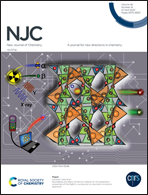Pyrazole-, isoxazole- and pyrrole-ring fused derivatives of C60: synthesis and electrochemical properties as well as morphological characterization†
Abstract
Currently, fullerene-based molecules are still the most widely used electron acceptor materials in organic photovoltaic cells (OPVs). Such fullerene adducts are notable for their strong electron accepting capability as well as excellent electron mobility and solubility. Here, we report the synthesis and characterization of new isoxazolo- and pyrrolo[60]fullerene adducts. In addition, their electronic and electrochemical properties were investigated and compared with the reported pyrazolo[60]fullerene by means of absorption spectra, electronic structure calculation, and cyclic voltammetry (CV), respectively. According to the results, the redox properties, LUMO, HOMO, and the optical band gap (Eoptg) of the synthesized fullerene derivatives were comparable with the well-known phenyl-C61-butyric acid methyl ester (PC61BM), making them promising materials for photovoltaic applications. Also, morphological characterization by scanning electron microscopy (SEM) of the solid forms of the adducts revealed spherical and flowerlike supramolecular assemblies.



 Please wait while we load your content...
Please wait while we load your content...